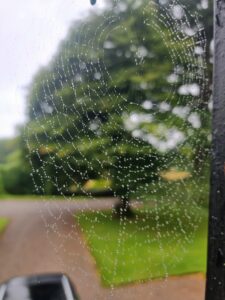This morning I found a spider’s web starred with dew snagged on my balcony railing.
Have you ever noticed how the tiniest shift in the air can send reverberations all the way through to the edge of this universe?
In the same way, a gentle tug on a single strand of our history with a particular emotional charge can also suddenly spill out in a series of impulses, behaviours, defences. This is called a complex. By connecting the dots, a pattern – there we have it, a constellation.
Complexes
When strands of our personal history get triggered or activated, Jung referred to it as a complex that was constellated. They play out in a person’s attitude and actions.

This space is full of potent energy and reaction. Reaction can be acting out or withholding to control the situation. It’s like a pendulum swing, one or the other, black or white.
These triggers of course can be both positive or negative experiences, but when the imposed patterns are unhelpful and not consciously recognised, they can get us into all sorts of trouble with impulsiveness and knee-jerk reactions.
A labyrinth I’ve had to walk through in my own ‘shadow’, has been the surprisingly common codependent and narcissist dynamic.
(As a recovered codependent, I’d recommend some wonderful resources out there; Melody Beattie’s books, Ross Rosenburg’s The Human Magnet Syndrome, Dr. Ramani Durwala’s work to name just a few.)
So this is one area where I am constantly invited to fine-tune my awareness and unravel the threads of nuance.
Within the narcissistic personality spectrum, the ‘covert’ type is notoriously difficult to figure out. Accurately discerning the common red flags can become very tricky; how can one accurately tell apart a generally ‘self-centred’ person for instance? … But more on this in a later post.
Root Trauma and the Shaky Sense of Self
The interesting and well documented fact is that the root trauma for both codependent and narcissistic personalities is likely to stem from a similar childhood wound, but they develop different coping mechanisms to forestall the pain. What they have in common is, there is a void within.
One way I imagine the narcissistic personality is as a set of nested Russian dolls where there is a great distance between the outermost layer is the Persona and the true Self, as the Self has receded so far in, that it is very hard for the individual to access. They mostly encounter a silence.
In the other camp, the example of the clinically benign self-focused person, or the codependent, are considered more psychologically ‘permeable’, with a greater capacity to heal. Yet they also display the same basic lack self awareness and experience an inner silence that’s hard to penetrate.
Often, they’ve had no positive experiential reinforcement or role models to draw on. There’s been no reparative relationships. But I’d say there is a different quality to this silence; I can best describe it as a sense of confusion and befuddlement, though there is a sensing of the deeper Self.
I imagine this camp to have a hard-shelled Persona like barnacles on the hull of a ship, a sort of defensiveness against the outer world. The vicarious effect is it shuts them off from the inner world too. But this group does tend to have a relatively more straightforward route to to wellbeing by developing awareness.
Inner Silence, Unacknowledged Loneliness and the Dead Mother Archetype
The idea of root trauma inevitably brings us into the realm of the Mother archetype. The Spider is a motif of the Great Mother, the creator of the web of life.
The best resource on this primordial image in the human psyche, both in the light and shadowy fearsome aspects, is Erich Neumann’s book The Great Mother.
A sub-story of the disintegrated expression of this archetype is the Dead Mother.
The late André Green (associated with Melanie Klein and Wilfred Bion) has one of the most heartbreaking and powerful insights on the Dead Mother archetype.
In his collection of essays On Private Madness, Green illustrates an undercurrent that feels very widespread, and sheds light on a kind of suffering that can more easily addressed, if only the bigger picture is clearly seen and understood.
The cause is often a one-off event, of fairly short duration, though the repercussions are a messy bag, and life-long.
What happens is the mother or the primary caregiver is initially emotionally engaged with her child, but then something transpires to switch them off.
This can happen for all sorts of benign and unanticipated reasons such as a sudden death, postpartum depression or any misfortune. I wonder about infants who needed to be kept intubated too.
The caregiver may well return to the role of nourishing mother. But in the stopgap there is a sudden cut off of the sustenance of emotional resonance which leads to a profoundly deep emotional detachment in the child. Green believes it gives rise to infantile depression that lacks any kind of language to be verbalised.
This cut-off of feeling is experienced by the child as something brutal it cannot understand, is helpless to repair. The child feels impotent in its attempt to create any kind of connection.
Inner Exile and the Inability to Invest in Life
Green describes how he begins to become suspicious that there is a dead mother complex at play; a sense of coldness, hardness and an inability to feel. He also notes that there is no access to aggression (the kind that’s necessary to stand up for one’s own convictions?) because they would have driven the mother/carer further away.
The result is that the child takes on the refusal to invest deeply in any relationship, the self or other.
Because the child is identified with the emotionally dead mother, it begins the lifelong pattern of repeating the feeling of sadness and inability to invest in life, invest in relationships. For this child emotions are a foreign language. Intimacy is terrifying. It’s painful to commit to anything or stay committed. There’s always the instinct to escape, a flightiness, and the reflex habits of pessimism and shutdown are the only options when emotionally challenged.
Relationships as Process
I believe it would be hard too for such a child grown up to see relationships – with self and other – as a continual flow of investment. They will find it hard to trust, hence also the possibility of the continuity of being loved, and their own ability to keep loving.
Current research also shows how pre-natal stresses of the mother transfers biologically to the foetus, yet another interruption in the mother-child relationship.
These are incredible burdens to carry for the child and for the mother.
The Dead Mother archetype is possibly the deepest source of loneliness that goes unacknowledged, because its inception is pre-linguistic, and resulting compensatory behaviours hard to trace to the source.
This self-estrangement can manifest in a plethora of destructive or controlling behaviours, addictions, seeking external validation (for example relying on financial success to provide self worth), as attempts to fill a void that cannot be filled if it remains hidden.
I often return to Jung’s belief that we don’t so much solve our problems; we outgrow them. But this one – It is a tough conundrum to unravel.
Developing awareness and reparative relationships may only scratch the surface in the initial stages of healing (but prove to be the integrating experiences in later stages). For that first recalibration however, transference in an analytic relationship is often the recourse to get to the bedrock of this wounding.
You can read Green’s full essay here: https://web.english.upenn.edu/~cavitch/pdf-library/Green_Dead_Mother.pdf
© 2021 Amali Gunasekera. All rights reserved.

